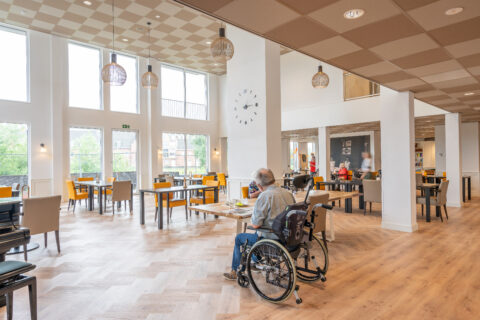


In a DGBW session moderated by Petran van Heel, Sector Banker Construction & Real Estate at ABN AMRO, the current market of green bonds and real estate investments was discussed. A green bond is a bond that investors can use to invest in sustainable projects, such as loans for sustainable real estate. It is a relatively new product in an interesting, growing market.
With three colleagues – Joop Hessels, Shanawaz Bhimji and Bas Rutten – Petran hits several topics on financing of real estate, the green bond market the impact of the new EU Taxonomy, and the level of sustainability in real estate. 'Banking for Better, for generations to come' is not only the purpose of the Amsterdam based banking firm, it also refers to 'the legacy that we are building right now', the colleagues agree.
Investing in 'green' real estate or green bonds is not something for the future, it is happening right now. As Shanawaz Bhimji, Senior Fixed Income Strategist Corporate Credit at ABN AMRO tells 'Real estate is of particular interest, it is the second market in the ranking for green bonds. We were the first European bank to introduce green bonds three years ago. The growth has been spectacular. Investments in sustainable real estate, with green ánd social angles, especially long term value transactions, are a double whammy for investors!'
His colleague Joop Hessels, Head of Green Social & Sustainability Bonds , confirms the growing demand for green bonds, but presses that the definition of 'green' needs to be formalized: 'Green bonds are traded in an international market, where every country has its own definitions and legislation for sustainability. An energy Clabel in one country can be classified as very good, whereas in The Netherlands a C is just average. You have to put the sustainability goals in a local perspective, to be able to measure their value for the investor.'
The EU Taxonomy that Frans Timmermans has announced, will introduce new legislation and a (more) level playing field. Bas Rutten, Head of CB Real Estate Large Accounts, has high expectations: 'If you want to raise the bar of sustainability, legislation is needed. A level playing field is imperative, for private and public parties. We need full support from the governments to go ahead. EU Taxonomy could be that support.' Joop agrees: 'Everybody needs a dot on the horizon towards meeting the goals of the Paris Agreement. It allows you to have a good discussion with your colleagues and clients about how to reach the needed level of sustainability.'

Petran and Bas just confirmed a deal for a large investment in a project that comprises social housing, affordable housing for young people, a high level of sustainability and a decent volume: 'Another double whammy', jokes Petran. 'It is a very attractive combination of functions and ambitions', Bas admits: 'Every asset class in real estate has its own dynamics. Investors in housing look at many aspects, not only the building or dwellings itself: it is about the location in the city, the local dynamics, health and wellbeing, safety, etcetera. Buildings for logistics are much easier to validate, for example.'
Shanawaz sees a 'bright and green future for green bonds in real estate. But..', he warns with a feel for drama: 'investors love diversification. The market for real estate green bonds shows a little fatigue: sustainable automotive and green tech investments are drawing a lot of interest. The EU Taxonomy could turn the heads toward real estate again: with a level playing field, new regulations and reliable definitions for sustainability.'
Another instrument that will help with decision making is the Sustainable Investment Tool that ABN AMRO has developed. Bas confirms: 'Investors and project developers will benefit from this data driven tool. It takes you through a sequence of criteria and possibilities, as a matrix for decision making, a roadmap for a more sustainable building. This is a great tool for a relatively young market. Every company needs a plan of action, to realize a strong reduction of it's carbon footprint. We learn new things every day and want to walk through this process with our clients.'
The four colleagues feel that need of urgency, that much is clear. The title of this session 'Banking for Better' is spot on, they agree. Bas: 'We are not talking about the quality of the balance sheet. It is a mission statement. We are building a legacy.' Joop adds: 'In the banking world we work a lot with risk management: we were used to look back and make decisions based upon history. Our corporate ambition to do things differently allows us to look forward and create a sustainable portfolio.' From his perspective, Shanawaz confirms the importance of building a legacy: 'It will convince investors of the reliability of the real estate market. It will give the financial market a comfortable feeling about investing in real estate.'



















